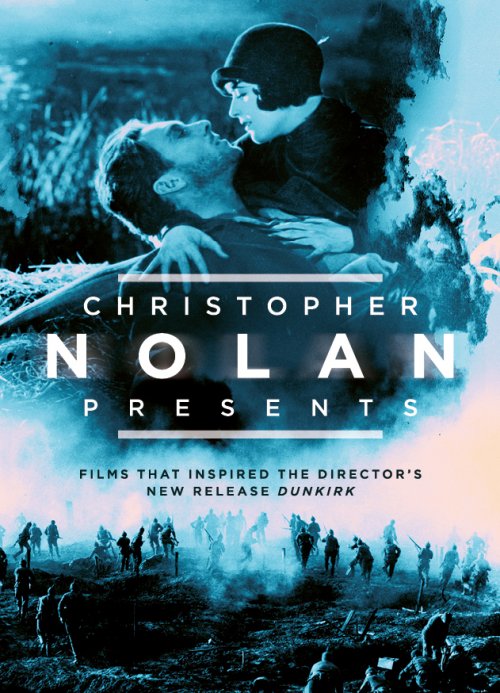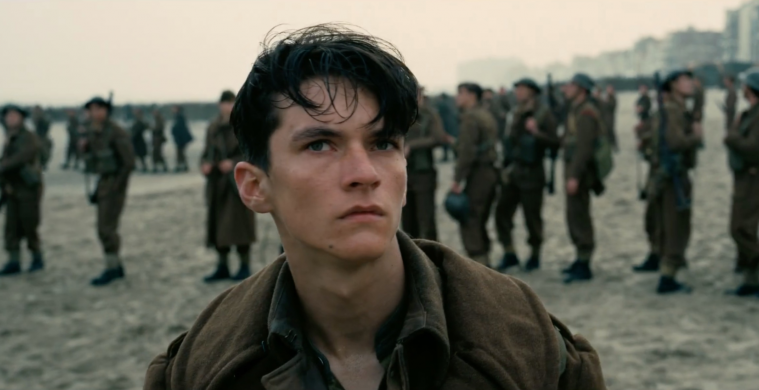
“I spent a lot of time reviewing the silent films for crowd scenes –the way extras move, evolve, how the space is staged and how the cameras capture it, the views used,” Nolan said earlier this year when it came to the creation of his WWII epic Dunkirk, referencing films such as Intolerance, Sunrise: A Song of Two Humans, and Greed, as well as the films of Robert Bresson.
Throughout the entire month of July, if you’re in the U.K., you are lucky enough to witness a selection of these influences in a program at BFI Southbank. Featuring all screenings in 35mm or 70mm — including a preview of Dunkirk over a week before it hits theaters — there’s classics such as Greed, Sunrise, and The Wages of Fear, as well as Alien, Speed, and even Tony Scott’s final film.
Check out Nolan’s introduction below, followed by the full list of screenings and see more details on BFI’s site.

You might expect a season of films leading up to a screening of Dunkirk to be a selection of war movies. But I chose to approach Dunkirk more as survival story than war film. One look at James Jones’ essay on ‘Phony War Films’ (in which he takes down several of my old favourites) immediately shows you the perils of taking on real-life combat in a dramatic motion picture. In Jones’ estimation All Quiet on the Western Front (Lewis Milestone, 1930) said it first and best: war dehumanises. Revisiting that masterpiece it is hard to disagree that the intensity and horror have never been bettered. For me, the film demonstrates the power of resisting the convention of finding meaning and logic in individual fate. Most of the other films in this series fall into two different, but overlapping categories. From established classics of tension like The Wages of Fear (Henri-Georges Clouzot, 1953) and Alien (Ridley Scott, 1979) through to the more recent ticking-clock nail-biters Speed (Jan de Bont, 1994) and Tony Scott’s final film, the relentless Unstoppable (2010), our season explores the mechanics and uses of suspense to modulate an audience’s response to narrative.
Other titles explore the possibilities of purely visual storytelling, whether literally, in the case of the silent epics – Stroheim’s Greed (1924) and Murnau’s Sunrise (1927) – or in part, like the thrilling windswept beaches and crashing waves of Ryan’s Daughter (David Lean, 1970). The relationship of geographical spectacle to narrative and thematic drive in these works is extraordinary and inspiring. Pure cinema. The Battle of Algiers (Gillo Pontecorvo, 1966) is a timeless and affecting verité narrative, which forces empathy with its characters in the least theatrical manner imaginable. We care about the people in the film simply because we feel immersed in their reality and the odds they face. The visual splendour, intertwined narratives and aggressively anachronistic music of Hugh Hudson’s Chariots of Fire (1981) combined to create a masterpiece of British understatement whose popularity rapidly obscured its radical nature. Finally, no examination of cinematic suspense and visual storytelling would be complete without Hitchcock, and his technical virtuosity in Foreign Correspondent’s (1940) portrayal of the downing of a plane at sea provided inspiration for much of what we attempted in Dunkirk. All the films are screened on 35mm or 70mm prints. I hope you will enjoy the rare opportunity of seeing these incredible movies in their original analogue glory, as nature intended.
Preview: Dunkirk + intro by director Christopher Nolan
Netherlands-UK-France-USA 2017. Dir Christopher Nolan. With Tom Hardy, Cillian Murphy, Mark Rylance, Kenneth Branagh. RT and cert TBC. 70mm. Courtesy of Warner Brothers
Dunkirk opens as hundreds of thousands of British and Allied troops are surrounded by enemy forces. Trapped on the beach with their backs to the sea they face an impossible situation as the enemy closes in. We’re delighted to screen Nolan’s much anticipated vision of an event that shaped our world.
Greed
USA 1924. Dir Erich von Stroheim. With Gibson Gowland, Zasu Pitts, Jean Hersholt. 132min. 35mm. PG. With live piano accompaniment
Hollywood’s more serious stabs at realist fiction emulate the social and psychological nuances of the 19th-century novel, and no one has taken American film further down that road than Stroheim. Shot on location in San Francisco and Death Valley, the film was cut to less than a third of its original nine hours, but remains extraordinary for its unflinching vision of the corrosive power of money.
Sunrise: A Song of Two Humans
USA 1927. Dir FW Murnau. With George O’Brien, Janet Gaynor, Margaret Livingston. 94min. 35mm. With score. U
Murnau’s foray into American cinema sees him construct a world free of geographic and social specifics – a dreamlike rural landscape and a brash cityscape that is everywhere and nowhere. Made at the end of the silent era, it pioneered the use of synchronous sound on film, for Reisenfeld’s score as well as such sound effects as traffic, whistles and church bells. Sunrise stands as a haunting fable – a dream of crime, love, loss and redemption.
All Quiet on the Western Front
USA 1930. Dir Lewis Milestone. With Lew Ayres, Louis Wolheim, John Wray. 133min with restored soundtrack. 35mm. PG
All Quiet on the Western Front is rightly recognised as one of cinema’s most enduring and emotive portrayals of the tragedy of the Great War. This epic film concerns a generation of German schoolboys who – exhorted by their patriotic teacher – enlist enthusiastically but are ultimately destroyed in the war. Based on Erich Maria Remarque’s classic novel, the film proved highly controversial and was banned in many countries.
Considering All Quiet on the Western Front
TRT 90min
During WWI, Lewis Milestone, a recent Russian émigré to the US, made films for the Signal Corp, and this experience undoubtedly informed his 1930 Hollywood masterpiece, All Quiet on the Western Front. Film historian Kevin Brownlow (who interviewed Milestone about his film career in the 1960s) will be joined by film professional Mamoun Hassan to discuss – alongside film clips and a rare trailer – the history and achievement of what is considered to be the greatest anti-war film of all time.
Foreign Correspondent
USA 1940. Dir Alfred Hitchcock. With Laraine Day, George Sanders, Joel McCrea. 119min. 35mm. PG
Made partly to raise the American public’s awareness of the Nazi threat, this picaresque espionage adventure follows a US journalist to London and Holland to cover a mooted peace treaty; instead, with the help of a diplomat’s daughter, he uncovers a conspiracy. Set pieces abound, including one at Westminster Cathedral and a windmill that conceals a sinister secret.
The Wages of Fear Le salaire de la peur
France-Italy 1953. Dir Henri-Georges Clouzot. With Yves Montand, Charles Vanel, Véra Clouzot. 147min. 35mm. EST. PG
Watched by a hungry vulture, a child plays with cockroaches in the dusty street of a South American shantytown. So begins one of the most nerve-wrackingly suspenseful films ever made, as four desperados take on a suicidal mission to drive two trucks full of nitro-glycerine along precipitous, pot-holed roads. As the tension mounts, this journey to hell is propelled to its misanthropic conclusion by a truly unsettling score.
The Battle of Algiers La battaglia di Algeri
Algeria-Italy 1966. Dir Gillo Pontecorvo. With Jean Martin, Yacef Saadi, Brahim Hadjadj. 121min. 35mm. EST. 15
Algiers functions as both the site and symbol of struggle in this dazzling reconstruction of nationalist opposition to French occupation during the 1950s. The Old City nurtures and shelters the guerrilla fighters who, despite brutal reprisals, repeatedly venture from it to attack the colonial might of the new ‘European’ city. Battle of Algiers is an award-winning masterpiece of political cinema.
Ryan’s Daughter
UK 1970. Dir David Lean. With John Mills, Sarah Miles, Robert Mitchum. 194min (+ interval). 70mm. 15
With a harsh critical response at the time of its release, Ryan’s Daughter is a triumph of sensual storytelling for David Lean. Robert Bolt’s script reworks Hardy-esque formulae into a story about romantic excess and moral cowardice, set during the Troubles of 1916, woven into a vision of damnation. Freddie Young and John Mills won Oscars®, and deservedly so.
Alien
UK-USA 1979. Dir Ridley Scott. With Sigourney Weaver, John Hurt, Ian Holm. 116min. 35mm. 15
The Alien phenomenon began here as the crew of the Nostromo are woken from stasis by the ship’s computer and grudgingly sent to investigate a transmission of unknown origin. They discover a deadly alien species and as the crew are picked off one by one, Ripley takes her place as the ultimate sci-fi heroine. This iconic classic features designs from HR Giger and a brilliant script by Dan O’Bannon.
Chariots of Fire
UK 1981. Dir Hugh Hudson. With Ben Cross, Ian Charleson, Ian Holm, Nicholas Farrell. 123min. 35mm. PG
Hugh Hudson’s visually magnificent, emotionally exhilarating account of the struggle by Harold Abrahams and Eric Liddell to compete on their own terms at the 1924 Olympics seemed to herald a new highpoint in British cinema and was a hit at the Oscars®. With fine use of slow motion, Chariots of Fire tugged at the heartstrings of a nation.
Speed
USA 1994. Dir Jan de Bont. With Keanu Reeves, Sandra Bullock, Dennis Hopper. 116min. 35mm. 15
This blockbuster hit has non-stop, edge of the seat thrills and spills. Reeves turns in a strong performance as the hero, a SWAT cop dealing with a crazed bomber who has wired up a bus to explode if the speed drops below 50mph. Bullock shines as the feisty passenger at the steering wheel. A thoroughly enjoyable roller-coaster ride of a movie.
Unstoppable
USA 2010. Dir Tony Scott. With Denzel Washington, Chris Pine, Rosario Dawson. 98min. 35mm. 12A
With the poster tag line reading ‘1 million tonnes of steel, 100,000 lives at stake, 100 minutes to impact’, Tony Scott’s final film as a director is about a runaway freight train, a retired railroad engineer and a rookie conductor who must figure out a way of trying to avert disaster. It’s a well-made, suspenseful thriller that works as a great companion piece to Speed.

